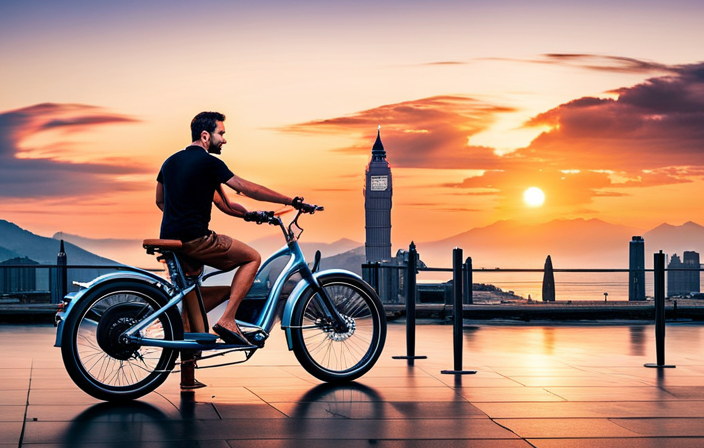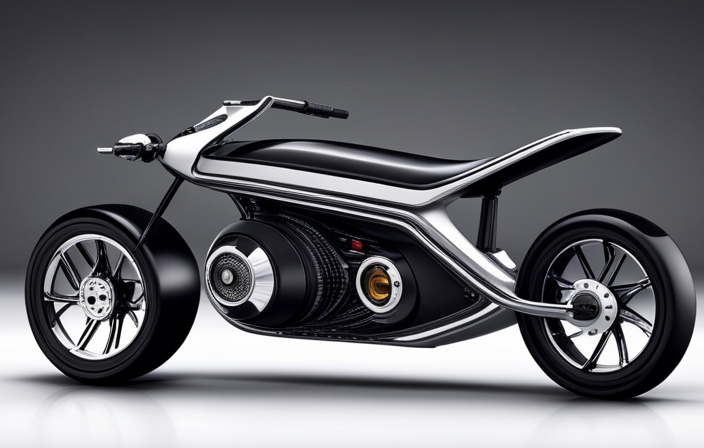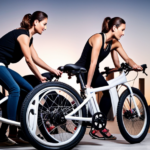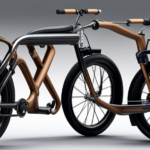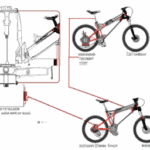Did you know that the average American spends over $2,000 a year on gas for their car?
Imagine if you could save that money and reduce your carbon footprint by building your own cruiser electric bike!
In this article, I will guide you through the step-by-step process of building your very own electric bike.
From choosing the right frame to installing the motor and battery system, you’ll have all the information you need to create your own eco-friendly mode of transportation.
Let’s get started!
Key Takeaways
- Gather all necessary components and tools for building the electric bike.
- Follow step-by-step instructions for assembly and ensure proper wiring and connections.
- Test the battery and motor functionality and fine-tune the bike for optimal performance.
- Conduct a test ride, evaluate performance, and make necessary adjustments for better performance.
Gather the Necessary Tools and Materials
You’ll need to gather the necessary tools and materials to build a cruizer electric bike. Choosing the right tools is crucial to ensure a smooth construction process.
Some essential tools to have include a set of screwdrivers, wrenches, pliers, and a wire cutter. Additionally, a soldering iron and a multimeter will be necessary for electrical connections and testing.
When it comes to finding affordable materials, it’s important to do some research and compare prices from different suppliers. Look for deals and discounts, as well as consider purchasing used parts in good condition. Remember that safety should always be a priority, so invest in quality materials that meet industry standards.
Now that you have all the necessary tools and materials, let’s move on to the next step: choosing the right frame for your electric bike.
Choose the Right Frame for Your Electric Bike
To choose the right frame for your e-bike, consider factors such as your height, riding style, and terrain preferences.
When it comes to choosing frame materials, there are several options available, each with its own advantages and disadvantages. Aluminum frames are lightweight and corrosion-resistant, making them a popular choice for electric bikes. Steel frames, on the other hand, offer durability and strength, but can be heavier. Carbon fiber frames are the lightest and provide excellent vibration dampening, but they can be more expensive.
When comparing different frame designs, you’ll want to consider factors such as frame geometry and suspension options. A step-through frame is great for easy mounting and dismounting, while a step-over frame offers more stability.
Now that you’ve chosen the right frame, let’s move on to selecting the motor and battery system.
Select the Motor and Battery System
When selecting the motor and battery system, it’s important to consider factors such as power output, range, and charging time.
Here are four key factors to consider when choosing the motor and battery for your electric bike:
-
Motor selection: Choose a motor that matches your desired power output and torque requirements. Consider factors such as the motor’s wattage, voltage, and efficiency.
-
Battery capacity: Select a battery with sufficient capacity to provide the desired range for your electric bike. Consider factors such as the battery’s voltage, ampere-hour (Ah) rating, and chemistry.
-
Integration: Ensure that the motor and battery system can be easily integrated onto your chosen frame. Consider factors such as the motor mounting options and the battery’s dimensions and weight.
-
Compatibility: Check the compatibility between the motor and battery system. Ensure that they can work together seamlessly to provide optimal performance and efficiency.
With the motor and battery system selected, it’s time to move on to the next step: installing the motor and battery onto the frame.
Install the Motor and Battery onto the Frame
First, make sure the frame of your bicycle is compatible with the motor and battery system you have selected. The installation process of the motor and battery onto the frame is crucial for the functionality of your electric bike. To help you understand the steps involved, refer to the table below which outlines the key components and their placement during the installation process.
| Component | Placement |
|---|---|
| Motor | Bottom bracket |
| Battery | Rear rack |
| Controller | Frame |
When installing the motor, ensure that it aligns properly with the bottom bracket of the frame and is securely fastened. Next, attach the battery onto the rear rack, ensuring it is centered and well-supported. Finally, mount the controller onto the frame in a location that allows for easy access and protection from the elements.
Troubleshooting common installation issues may include checking for loose connections, ensuring proper alignment, and verifying that all components are securely attached. Once the motor and battery are successfully installed, you can proceed to connect them to the electric bike’s system, which will be discussed in the subsequent section.
In the next section, we will explore how to connect the motor and battery to the electric bike’s system.
Connect the Motor and Battery to the Electric Bike
Now, let’s connect the motor and battery to the electric bike’s system. This step is crucial in ensuring the smooth functioning and optimal performance of your cruiser electric bike.
To begin, make sure the motor and battery are securely attached to the frame. Double-check all the connections and ensure they are tight and properly aligned.
Once you have confirmed the physical connection, it’s time to troubleshoot common issues. Check that the cables are correctly connected and that there are no loose wires. It is also essential to ensure that the battery is fully charged before connecting it to the motor. This will maximize the efficiency of the motor and battery system.
Lastly, make sure to follow the manufacturer’s instructions carefully to avoid any potential damage or malfunctions.
With the motor and battery successfully connected, we can now move on to the next step of installing the controller and wiring.
Install the Controller and Wiring
After successfully connecting the motor and battery, it’s time to move on to the next crucial step: installing the controller and wiring.
The controller is responsible for regulating the power flow from the battery to the motor, making it an essential component of your electric bike. Start by selecting a reliable controller from recommended brands like Bafang or Grin Technologies.
Once you have the controller, follow the manufacturer’s instructions to mount it securely on your bike’s frame. Take extra care to ensure that all the wiring connections are properly insulated and protected against moisture and vibrations. Troubleshooting common issues like loose connections or faulty wiring is crucial to ensure the smooth functioning of your electric bike.
Now, let’s transition to the subsequent section where we will learn how to attach the handlebars, seat, and pedals.
Attach the Handlebars, Seat, and Pedals
To attach the handlebars, seat, and pedals, you’ll need to follow the manufacturer’s instructions and ensure a secure and comfortable fit. Here are the steps to accomplish this:
-
Adjusting the seat height and position for optimal comfort is crucial. Start by loosening the seat clamp and adjusting the height according to your preference. Ensure that it is secure before tightening the clamp. Next, position the seat forward or backward to achieve a comfortable riding position.
-
Choosing the right handlebar grips is essential for a comfortable and secure grip. Consider grips that provide cushioning and absorb vibrations for a smoother ride. Install them by sliding them onto the handlebars and tightening the screws or bolts.
-
Attach the pedals by aligning the threads with the crank arms and screwing them in. Ensure they are tightened securely to avoid any accidents while riding.
Once you’ve completed these steps, you can move on to the next section, where you will test and adjust the electric bike’s performance to ensure it meets your requirements.
Test and Adjust the Electric Bike’s Performance
Start by testing and adjusting the performance of your newly assembled electric bicycle to ensure it meets your desired specifications. To begin, you need to check the battery voltage and ensure it is fully charged. Next, assess the bike’s speed by taking it for a test ride on a flat surface. Use a GPS device or speedometer to accurately measure the bike’s top speed. If necessary, adjust the speed settings on the controller to achieve your desired maximum speed. Additionally, test the braking system to ensure it is responsive and stops the bike effectively. Finally, evaluate the bike’s overall performance and handling by riding it on different terrains and inclines. Make any necessary adjustments to the suspension, tire pressure, or gear ratios for optimal performance. Once you have fine-tuned your electric bike, you can move on to customizing it with accessories to enhance your riding experience.
Customize Your Electric Bike with Accessories
After thoroughly testing and adjusting the performance of your electric bike, it’s time to add a personal touch by customizing it with stylish accessories.
This will not only enhance the overall look of your DIY cruiser electric bike but also provide additional features to enhance safety.
There are a plethora of accessories available in the market specifically designed for electric bikes, such as fenders, racks, lights, and bells.
Fenders will keep mud and dirt away from you while riding, racks will provide extra storage space for your belongings, lights will ensure visibility during night rides, and bells will help you alert pedestrians and other cyclists.
By carefully selecting and installing these accessories, you can create a unique and functional electric bike that suits your preferences and needs.
So, let’s dive into the next section and learn how to enjoy riding your DIY cruiser electric bike!
Enjoy Riding Your DIY Cruiser Electric Bike!
Get ready to have a blast riding your customized DIY cruiser e-bike! Now that you have built your own electric bike and added all the accessories, it’s important to know how to properly maintain it.
DIY electric bike maintenance is crucial for ensuring a smooth and enjoyable ride. One important aspect of maintenance is choosing the right tires for your electric bike. The type of tires you choose will greatly affect the performance and comfort of your ride.
Consider factors such as the terrain you will be riding on, the weather conditions, and your preferred riding style. If you will be riding mostly on paved roads, slick or semi-slick tires would be a good choice. For off-road adventures, opt for knobby tires that offer better grip and traction.
Regularly check the tire pressure, tread wear, and any signs of damage to ensure your electric bike is safe and ready for your next exciting ride.
Frequently Asked Questions
How long does it take to build a cruiser electric bike from start to finish?
It typically takes several hours to build a cruiser electric bike from start to finish. To troubleshoot common issues, check the wiring connections and test the battery. To maintain battery life, avoid overcharging and store the bike in a cool, dry place.
Can I use any type of bike frame for my electric bike conversion?
Yes, you can use different types of bike frames for electric bike conversion. Factors to consider include frame material, weight, geometry, and compatibility with motor and battery.
What is the average cost of the necessary tools and materials for building an electric bike?
On average, the necessary tools and materials for building an electric bike can cost around $500 to $1000. These expenses include items such as a motor kit, batteries, charger, wiring, connectors, and basic hand tools.
Are there any specific safety precautions I should take when installing the motor and battery onto the frame?
When installing the motor and battery onto the frame, it is crucial to take safety precautions. Proper wiring and insulation are of utmost importance to prevent electrical hazards and ensure the smooth functioning of the electric bike.
Can I upgrade the motor and battery system in the future if I want more power or longer range on my electric bike?
Yes, you can upgrade the motor and battery system in the future to enhance performance. However, it is important to consider compatibility issues between the new components and your bike’s frame, wiring, and controller.
Conclusion
After hours of hard work and dedication, I’ve finally completed my DIY cruiser electric bike. The feeling of accomplishment is overwhelming as I stand back and admire my creation.
With the right frame, motor, and battery system, I’ve built a powerful and efficient electric bike. As I prepare to take it for a test ride, I can’t help but feel a sense of anticipation and excitement.
The possibilities are endless as I imagine all the adventures I’ll have on my customized electric bike. It’s time to hit the road and enjoy the ride!
